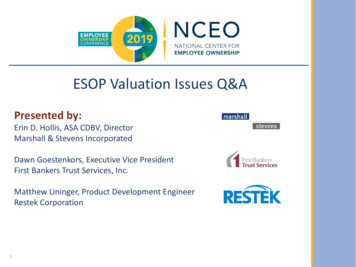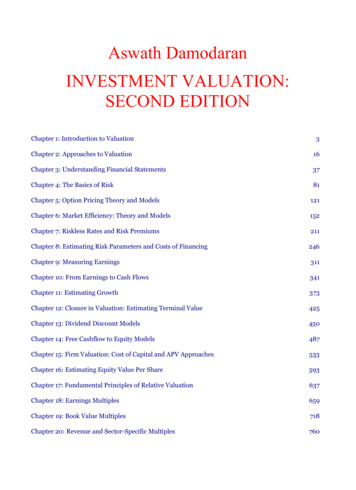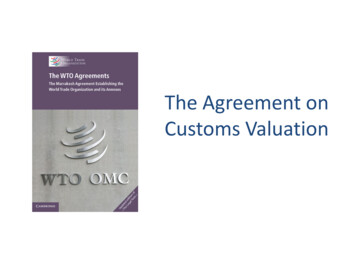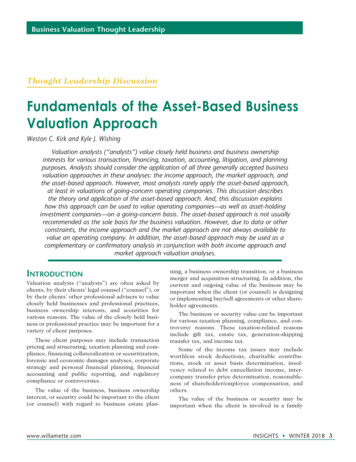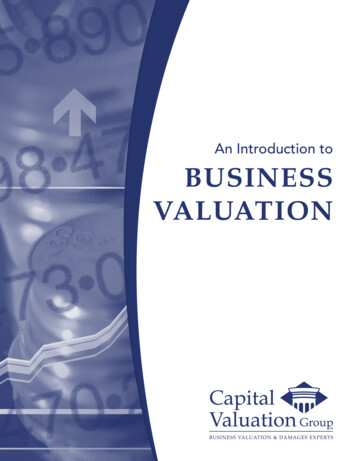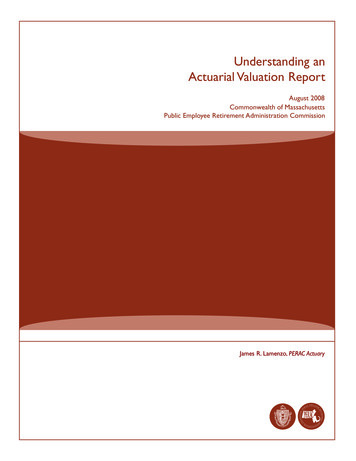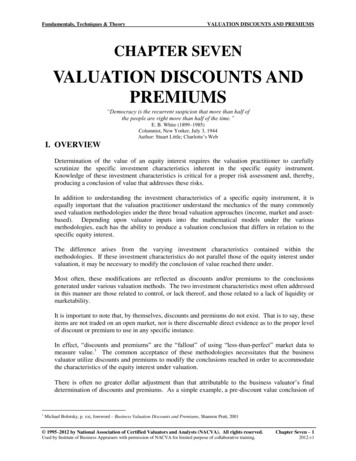
Transcription
Fundamentals, Techniques & TheoryVALUATION DISCOUNTS AND PREMIUMSCHAPTER SEVENVALUATION DISCOUNTS ANDPREMIUMS“Democracy is the recurrent suspicion that more than half ofthe people are right more than half of the time.”E. B. White (1899–1985)Columnist, New Yorker, July 3, 1944Author: Stuart Little; Charlotte’s WebI. OVERVIEWDetermination of the value of an equity interest requires the valuation practitioner to carefullyscrutinize the specific investment characteristics inherent in the specific equity instrument.Knowledge of these investment characteristics is critical for a proper risk assessment and, thereby,producing a conclusion of value that addresses these risks.In addition to understanding the investment characteristics of a specific equity instrument, it isequally important that the valuation practitioner understand the mechanics of the many commonlyused valuation methodologies under the three broad valuation approaches (income, market and assetbased). Depending upon valuator inputs into the mathematical models under the variousmethodologies, each has the ability to produce a valuation conclusion that differs in relation to thespecific equity interest.The difference arises from the varying investment characteristics contained within themethodologies. If these investment characteristics do not parallel those of the equity interest undervaluation, it may be necessary to modify the conclusion of value reached there under.Most often, these modifications are reflected as discounts and/or premiums to the conclusionsgenerated under various valuation methods. The two investment characteristics most often addressedin this manner are those related to control, or lack thereof, and those related to a lack of liquidity ormarketability.It is important to note that, by themselves, discounts and premiums do not exist. That is to say, theseitems are not traded on an open market, nor is there discernable direct evidence as to the proper levelof discount or premium to use in any specific instance.In effect, “discounts and premiums” are the “fallout” of using “less-than-perfect” market data tomeasure value.1 The common acceptance of these methodologies necessitates that the businessvaluator utilize discounts and premiums to modify the conclusions reached in order to accommodatethe characteristics of the equity interest under valuation.There is often no greater dollar adjustment than that attributable to the business valuator’s finaldetermination of discounts and premiums. As a simple example, a pre-discount value conclusion of1Michael Bolotsky, p. xxi, foreword – Business Valuation Discounts and Premiums, Shannon Pratt, 2001 1995–2012 by National Association of Certified Valuators and Analysts (NACVA). All rights reserved.Used by Institute of Business Appraisers with permission of NACVA for limited purpose of collaborative training.Chapter Seven – 12012.v1
VALUATION DISCOUNTS AND PREMIUMSFundamentals, Techniques & Theory 1,000,000 would be reduced by 350,000, should the business valuator select a total discount of 35percent.Such significant numbers are not uncommon, resulting in an ever-growing attempt by the InternalRevenue Service, as well as various state inheritance tax authorities to challenge the validity of thevaluator’s conclusions. The Internal Revenue Service primary guidance is based on a foundation oflanguage contained in Revenue Ruling 59-60.Revenue Ruling 59-60, 1959-1 Cumulative Bulletin 237, defines fair market value as:“The price at which the subject equity ownership interest would change hands between awilling buyer and a willing seller when the former is under no compulsion to buy and thelatter is under no compulsion to sell and both parties having reasonable knowledge ofrelevant facts.”Court decisions frequently state that, in addition to a hypothetical buyer and seller being “willing,”they must also be “able” to trade and be well informed about the property and the market for suchproperty.Practice PointersRevenue Ruling 59- 60 sets forth the premise that valuation of closely held business interests isnot an exact science and reasons that sound valuations result from:Consideration of all relevant factsUse of common senseExercise of informed professional judgmentApplication of reasoned assessmentA. OTHER DISCOUNTSOther value modifications beyond those considering control and marketability often include:1.2.3.4.5.6.7.8.9.10.11.Market absorption and blockage discountsKey person/thin management discountsInvestment company discountInformation access and reliability discountLack of diversification discountNon-homogenous assets discountRestrictive agreement discountSmall company risk discountSpecific company risk discountBuilt-in gains tax discountLiquidation costs discountIt is important to note that valuation professionals often compensate for value detrimentattributable to many of these items in the development of their discount/capitalization rates. Assuch, it is incumbent upon the business valuator to avoid a “double effect” of thesecharacteristics in his or her valuation conclusion.The key for successfully utilizing discounts and/or premiums is to truly understand theownership characteristics and attributes of the subject equity interest and the third partysupporting base data.2 – Chapter Seven2012.v1 1995–2011 by National Association of Certified Valuators and Analysts (NACVA). All rights reserved.Used by Institute of Business Appraisers with permission of NACVA for limited purpose of collaborative training.
Fundamentals, Techniques & TheoryB.VALUATION DISCOUNTS AND PREMIUMSDISCOUNTS AND PREMIUMS/ FUNDAMENTAL CONCEPTSThe fair market value of a business interest is determined by transactions between buyers andsellers. Ultimate estimation of fair market value under commonly accepted valuationapproaches and methodologies requires the business valuator to identify and consider thoseownership interest characteristics that are specific to the interest being valued.Investors are risk averse. Ownership interest attributes that increase the risk of holding theinvestment will inherently depress the value of the ownership interest. Likewise, those specificcharacteristics that serve to diminish investment risk will increase that ownership interest’svalue.The propriety of any discount or premium is undeterminable until the base to which theadjustments are applied is clearly defined. Utilization of discounts and premiums cannotproduce a correct result if applied to an inappropriate base conclusion of value.No “prescribed” levels or ranges of discounts or premiums exist from which the valuator canascertain the proper adjustments for a specific case. Moreover, the valuator cannot expect touse a common set of computations or formulas to determine the appropriate adjustments in jobswith differing facts and circumstances.Though not totally mutually exclusive concepts, the discount for a lack of ownership control(minority) and the discount for lack of marketability are generally held to be separate anddistinct. While it is true that some crossover exists whereby a non-controlling interest is lessmarketable than a controlling interest by virtue of the non-control feature, sufficient third partyinformation exists to support separation of the two. Otherwise, insurmountable difficulties arisein determining a proper level of combined discount.Practice pointerIn those instances where the business valuator deems it appropriate to apply both a discount forlack of ownership control and a discount for the lack of marketability, the application of thediscounts is multiplicative, not additive.The discount for lack of ownership control is generally applied first, principally due to thecommon understanding that both control and minority ownership interests may be subject to adiscount for a lack of marketability. Moreover, the only empirical data for lack of marketabilityis available at the minority interest level, further supporting the concept of applying theminority discount first.Due to specific characteristics requiring the application of discounts for both a lack of controland a lack of marketability, minority ownership interests in privately held businesses may beworth much less than their proportionate share of the overall business value. In other words, thesum of the parts may not add up to the whole. 1995–2012 by National Association of Certified Valuators and Analysts (NACVA). All rights reserved.Used by Institute of Business Appraisers with permission of NACVA for limited purpose of collaborative training.Chapter Seven – 32012.v1
VALUATION DISCOUNTS AND PREMIUMSFundamentals, Techniques & TheoryC. GENERAL FACTORS THAT INFLUENCE THE APPLICABILITY AND SIZE OFTHE DISCOUNT OR urpose of the valuation – divorce, estate, ESOP, etc.Attendant rights and characteristics of specific ownership interest being valuedTransfer restrictions or put optionOwnership structure of the entity being valued – voting vs. nonvoting sharesQuality of management team – thin management, strained family relationshipsSize of company – small “Mom and Pop” vs. large multifaceted businessSize of block of stock being valued – swing vote considerationPropriety of management salaries, perquisites, etc. – excess compensation and/or benefitsThe control of a minority shareholderStock-related issues – dividend policy and history, stock redemption policies, restrictions on stocksales, right of first refusal, etc.Financial condition of the subject company and volatility of earnings – bank restrictions ondividends, etc.Federal and state regulatory restrictions – Treasury regulations regarding estates/gifts;Department of Labor regarding ESOPsState corporation statutes – New York/Illinois supermajorityMarket desirability – struggling vs. thriving industryPotential synergies, if any, with potential buyer(s)Investment time horizonPass-through entitiesD. LEVELS OF VALUEThe business valuation community generally assumes four basic levels of value:1.2.3.4.Synergistic value (assumes a different standard of value)Controlling interest valueMarketable minority interest valueNon-marketable minority interest valueThe graphic below illustrates the various levels of value in terms of ownership characteristics.Control, Marketable Value(on an investment or synergistic value basis)Control, Marketable Value(on a FMV basis)SynergisticPremiumDiscount for Lackof ControlMinority, Marketable ValueMinority, Non-marketable ValueControlPremiumDiscount for Lackof MarketabilityNote the highest level of value is on an investment or synergistic value basis and not fairmarket value.A controlling interest in a privately held business may also be subject to a discount for lack ofmarketability, but usually not at the same level as a minority or non-controlling interest.4 – Chapter Seven2012.v1 1995–2011 by National Association of Certified Valuators and Analysts (NACVA). All rights reserved.Used by Institute of Business Appraisers with permission of NACVA for limited purpose of collaborative training.
Fundamentals, Techniques & TheoryE.VALUATION DISCOUNTS AND PREMIUMSCALCULATION OF TOTAL DISCOUNT APPLICABLE TO A SUBJECT INTERESTThe following example is provided to illustrate the multiplicative calculation of an overalldiscount applicable to a minority interest in a privately held business enterprise.Example:Gross value of entityX Subject percentage10% Interest (pre discounts)Less: Discount for lack of control (30%)Minority, marketable valueLess: Discount for lack of marketability (20%)Minority, non-marketable valueCalculation of overall discount: 1,00010% 100(30)70(14) 561 – [(1-.30) x (1-.20)]1 – [(.70) x (.80)]1 – .56.44Overall discount:44%Note that the total discount in the example is 44 percent, not 50 percent (the sum of the 30percent discount for lack of control and the 20 percent discount for lack of marketability).Although the Courts have erred in this matter of discount application, it is an accepted businessvaluation practice to apply the discounts sequentially.Discounts and premiums can play an important role in the determination of value in a privatelyheld business interest. The type and level of discount and/or premium can depend on numerousfactors as listed in C above.Almost universally accepted is the concept of four levels of value from which adjustments canbe made via discounts and premiums to attain the correct conclusion, given the specificcharacteristics of the ownership interest under valuation.II. CONTROL PREMIUM AND MINORITY INTEREST BASICSOf all the intrinsic characteristics related to an equity interest, arguably none may be more importantthan the element of control. Widely accepted theory within the business valuation community holdsthat an investment in a privately held company is worth the present value of all of the future benefitsinuring to the holder of that equity interest. Clearly, then, if the equity holder has a control position,he or she can accelerate the receipt of those future benefits and via management and operationalinitiatives, take direct steps to enhance the future benefits, or at least the probability that they will begenerated.On the other hand, a minority or non-controlling position in a privately held company is generallyheld at the great risk of being subject to the judgment, ethics and management skills of thecontrolling shareholder(s). Depending on a number of items, the impairment of value can besignificant in this circumstance. 1995–2012 by National Association of Certified Valuators and Analysts (NACVA). All rights reserved.Used by Institute of Business Appraisers with permission of NACVA for limited purpose of collaborative training.Chapter Seven – 52012.v1
VALUATION DISCOUNTS AND PREMIUMSFundamentals, Techniques & TheoryIt is not really proper to use the term minority discount in all cases. A minority discount is adiscount for lack of control applicable to a minority interest. A discount for lack of control is anamount or percentage deducted from the subject pro rata share value of 100 percent of an equityinterest to compensate for the lack of any or all powers afforded a control position in the subjectentity.Control premiums and discounts for lack of control, sometimes referred to collectively as “controladjustments,” have enjoyed wide acceptance in the federal tax system. The estate and gift taxregulations on valuing publicly traded stock recognize a basic inequality between controlling andnon-controlling interests, noting in Treasury regulation sections 20.2031-2(e) and 25.2512-2(e).“If the block of stock to be valued represents a controlling interest, either actual oreffective, in a going business, the price at which other lots change hands may have littlerelation to its true value.”Regulation sections 20.2031-2(f) and 25.2512-2(f) also list as a factor in valuing closely held stock“the degree of control of the business represented by the block of stock to be valued.” Theseprovisions prompt swing vote consideration as well.The primary IRS ruling on valuation of closely held shares, Revenue Ruling 59-60, clarifies whichway this factor cuts. The ruling states:“Although it is true that a minority interest in an unlisted corporation’s stock is moredifficult to sell than a similar block of listed stock, it is equally true that control of acorporation, either actual or in effect, representing as it does an added element of value,may justify a higher value for a specific block of stock.”Court decisions and rulings employing minority discounts and control premiums have become thestandard over the years, applying these principles not only to stocks, but other types of property aswell. The business valuation community in “non-estate/gift tax” venues also broadly accepts theapplication of these discounts.A. ADVANTAGES OF MAINTAINING A CONTROL POSITION IN A PRIVATELYHELD ENTERPRISE1.2.3.4.5.Setting company policy and influencing the operations of the businessAppointing management and determining management compensation and benefitsPower to acquire and dispose of business assetsPower to select vendors and suppliersFacilitating business reorganizations:a.b.c.d.e.6.7.8.9.10.6 – Chapter Seven2012.v1Business acquisitionsBusiness dispositionsLiquidationRecapitalizationInitial public offeringSell or acquire treasury sharesPower to dictate dividend policy and paymentsPower to revise company organization documentsAbility to establish or revise buy/sell documentsPower to block any of the above 1995–2011 by National Association of Certified Valuators and Analysts (NACVA). All rights reserved.Used by Institute of Business Appraisers with permission of NACVA for limited purpose of collaborative training.
Fundamentals, Techniques & TheoryB.CONSIDERATIONCONTROL1.b)c)Shareholder agreements setting shareholder responsibilities such as buy/sellagreementsEmployment agreementsVoting TrustsLimiting many advantages of controlSimple majority vs. super majorityRelated to control – the greater the shareholder’s control, the more significant thevoting rights become in the valuator’s determination of valuePotentially severe control limitations can arise in a business suffering from financialdifficultiesSize of the Block of Stock Being Valueda)9.Loan agreements with restrictive covenantsFinancial Condition of Businessa)8.Direct representationIndirect via cumulative voting sharesVoting Rightsa)7.ASSESSINGState Corporate Law and Statutesa)6.INIndustry Regulationsa)5.CHARACTERISTICSOther Agreements Including Organization Documentsa)4.OWNERSHIPContractual Restrictionsa)3.OFRepresentation on the Board of Directorsa)b)2.VALUATION DISCOUNTS AND PREMIUMSNoted in Revenue Ruling 59-60 as relevantConcentration of Ownershipa)A two percent interest in conjunction with two 49 percent interests would invoke alower minority discount than where the remaining 98 percent was held by 10 equalequity owners or a single shareholder. 1995–2012 by National Association of Certified Valuators and Analysts (NACVA). All rights reserved.Used by Institute of Business Appraisers with permission of NACVA for limited purpose of collaborative training.Chapter Seven – 72012.v1
VALUATION DISCOUNTS AND PREMIUMSFundamentals, Techniques & TheoryC. THEORETICAL ARGUMENTS FOR CONTROL PREMIUMS21.Performance Improvement OpportunityA perception by “control buyers” that they can run the company better and increase returnsvia operational improvements or synergistic benefits. Caution: synergistic benefits maypertain to other than “hypothetical buyer” and thus may alter standard of value.2.Investment Protection EnhancementControl is assumed to carry with it the ability to quickly act to modify operationaldecisions, thereby providing the interest holder with added investment protection notpresent in a non-control situation.3.Ability to Self-DealControl is assumed to carry with it the ability to withdraw excess financial benefits onterms favorable to the controlling equity holders. Examples include asset and opportunitydiversion, as well as receipts of excess cash flow related to compensation, related partyrentals, etc.4.Greater Information AccessA perception exists that controlling shareholders hold a higher level of access to companyfinancial and operational information than that available to non-control shareholders.5.Psychological and Intangible BenefitsTotally non-financial in nature, there is often thought to be a non-monetary benefit toholding the power of a controlling interest in a company. While difficult to quantify, thereis clearly a buyer group in the entire universe of buyers envisioned by Revenue Ruling 5960 that is willing to pay a premium for this privilege.D. THEORETICAL ARGUMENTS AGAINST CONTROL PREMIUMS1.Performance Improvement OpportunityFair market value assumes a hypothetical buyer from an entire universe of buyers and notan actual buyer. The question of assuming increased profitability is totally judgmental(what of the situation where increased profitability is totally judgmental? what of thesituation where the company already appears to be at an optimal performance level?).Certain court cases have rejected this argument as a reason for adding a control premium3.And, if this motive does indeed exist, would increased profitability not proportionallyaffect the value of all interests?2Federal Tax Valuation, John A Bogdanski, Warren, Gorman & Lamont, pp. 4-36.Ahmanson Found. vs. United States, supra note 161, 674 F2d at 770 (rejecting management replacement rationale in a particular case ongrounds that “companies were already very well managed”). Also, Continental Water Co. v. U.S., 49 AFTR2d 1070, 1078 (Ct. Cl. Tr. Div).38 – Chapter Seven2012.v1 1995–2011 by National Association of Certified Valuators and Analysts (NACVA). All rights reserved.Used by Institute of Business Appraisers with permission of NACVA for limited purpose of collaborative training.
Fundamentals, Techniques & Theory2.VALUATION DISCOUNTS AND PREMIUMSInvestment Protection EnhancementAgain, fair market value assumes a hypothetical buyer from an entire universe of buyersand not an actual buyer. Investment protection enhancement differs somewhat fromperformance improvement opportunity in that the former acts as a hedge againstunfavorable occurrences. The latter embraces an attitude of increasing the benefit stream.Note, however, the necessary operational moves to accomplish this task enhance noncontrolling share value, as well.3.Ability to Self-DealThe counter agreement to the use of a control premium for self-dealing is the statecorporation statutes in the U.S., whereby the control shareholders have a fiduciaryresponsibility to the non-control shareholders. As such, unfair transactions can bemediated by intervention of the courts, sometimes by having the minority shares redeemedat fair value.4.Greater Information AccessSecurities laws prevent trading on insider information. Additionally, many states prohibitcontrolling shareholders from trading on insider information. Lastly, state statutesprotecting non-control shareholders can play a role in equalizing information access.5.Psychological and Intangible BenefitsWhen assuming a hypothetical buyer, it is again difficult to place a quantifiable premiumon the base value that would be generally applicable to the entire universe of buyers.E.METHODOLOGIES FOR VALUING MINORITY INTERESTS1.2.3.Horizontal – computed by comparison with other minority interest transactionsTop Down – control value less applicable discountsBottom Up – start with minority value and add premiums for control interest valuationsMost practitioners prefer horizontal and/or top down; however, all approaches are viable.F.THE RANGE OF CONTROLThere are other levels of control/non-control positions in a privately-held enterprise; this chart isintended to provide some examples: 1995–2012 by National Association of Certified Valuators and Analysts (NACVA). All rights reserved.Used by Institute of Business Appraisers with permission of NACVA for limited purpose of collaborative training.Chapter Seven – 92012.v1
VALUATION DISCOUNTS AND PREMIUMSFundamentals, Techniques & TheoryCONTROLLING100 % Equity Ownership PositionControl Interest with Liquidating Control51% Operating ControlTwo equity holders, each with 50% interestMinority with largest block of equity interestMinority with “swing vote” attributesMinority with “cumulative voting” rightsPure minority interest – no control featuresLACK OF CONTROLG. SOURCES OF EMPIRICAL DATA ON CONTROL/MINORITY INTERESTS1.Mergerstat Review – published annually by Applied Financial Information LP(formerly Houlihan, Lokey, Howard & Zukin).a)b)c)d)e)f)g)2.Extensive analysis of tender offers and completed transactions by industryPublished yearly with historical data includedPremium paid over market is based on the seller’s closing market price five businessdays prior to the initial announcement of sale. Negative premiums are excludedMay understate the control premiums and implied minority interest discounts becausethe stock of the target’s acquisition may begin to rise more than five days prior to thepublic announcementIndustry-wide average for 2002 – 59.7 percentIndustry-wide median for 2002 – 34.4 percentImplied minority discount: 1 – [1/(1 Median premium paid)]Houlihan, Lokey, Howard and Zukin, Inc. (HLHZ) Control Premium Studya)b)c)Issued quarterlyData from 1986Study was undertaken to:(1) Quantify the difference, if any, in the premiums paid by synergistic buyers andthose paid by other types of buyers(2) Understand the composition of transactions, by type of buyer, in the ControlPremium Studyd)e)f)10 – Chapter Seven2012.v1The study determined that synergistic buyers generally pay similar or lower premiumsthan non-synergistic and other types of buyersThose performing the study stated that they found no evidence that an valuator needsto adjust the beta to result in a non-synergistic control premiumAttempts to select a price that is unaffected by pre-announcement speculation aboutthe proposed transaction 1995–2011 by National Association of Certified Valuators and Analysts (NACVA). All rights reserved.Used by Institute of Business Appraisers with permission of NACVA for limited purpose of collaborative training.
Fundamentals, Techniques & Theory3.VALUATION DISCOUNTS AND PREMIUMSSEC StudiesThese can be found in “The Effects of Dual-Class Recapitalizations on the Wealth ofShareholders” Office of the Chief Economist - SEC, June 1987, pp. 1-34.a)b)c)4.Studies compared the prices of two identical classes of publicly traded commonsecurities in the same company except one had voting privileges and the other did notMean average discounts – five to eight percentFor small minority interests, the value of voting rights is limited because of theirinability to influence the prerogatives of controlPartnership Profilesa)For a valuation of an entity such as a family limited partnership owning marketablesecurities, Partnership Profiles publishes two reports on closed-end funds:(1) Stock Closed-End Fund report – covers 43 closed end equity stock funds(2) Fixed Income Closed-End Fund Report – covers 30 closed-end bond fundsholding municipal, U.S. government, and corporate debt securities(3) Historical discount information is included on a monthly basis from 2001 to thepresentb)5.For a valuation of an entity such as a family limited partnership owning real estate,Partnership Profiles publishes a database of over 300 publicly-held limitedpartnerships that own real estate and real estate mortgages and trade on the secondarymarketMorningstar Principiaa)b)Provides a database on a monthly or quarterly subscription basis containinginformation on closed-end funds that own domestic and international stocks andgovernment, corporate, and municipal bondsProvides discounts used in the Price to Net Asset Value (P/NAV) method under theMarket Approach in valuing non-controlling interestsH. NTERESTPrimary base observations are extrapolated from the sale of controlling interests in freely tradedpublic companies. Numerous sales of this type occur annually with most transaction pricesincluding a premium over the market price at which the stock previously traded.1.2.The “premiums” associated with these controlling interest purchases are compiled and publishedby several services Most notable is Mergerstat Review 1995–2012 by National Association of Certified Valuators and Analysts (NACVA). All rights reserved.Used by Institute of Business Appraisers with permission of NACVA for limited purpose of collaborative training.Chapter Seven – 112012.v1
VALUATION DISCOUNTS AND PREMIUMSI.Fundamentals, Techniques & TheoryCALCULATING THE PREMIUMControl premiums are only applicable in valuations where you are starting with lack of controlvalue and you are trying to arrive at control value. In many valuations, control adjustments aremade to the benefit stream. In those cases, to add a control premium would be inappropriate.The most common practice is to observe the premiums in the public securities markets. Theprimary source of base information market evidence is Mergerstat Review. As described inthe 2006 publication, the Mergerstat database, published by Applied Financial Information L.P.“ includes formal transfers of ownership of at least 5% of a company’s equity andwhere at least one of the parties is a U.S. entity. When a transaction involves lessthan 100% of an entity, the percentage bought is stated after the seller’s name. WhenREM accompanies this percentage, the buyer already owns a portion of the sellingentity and this transaction will lead to 100% ownership. Data is collected for publiclytraded, privately owned and foreign companies.”The primary issue encompassed in utilizing the Mergerstat data is the composition of thepremium and the lack of clarity in the conclusions. Mergerstat generally develops the data bycomparing prices at which publicly traded companies are acquired with pre-acquisitionannouncement prices of the same stock. Mergerstat Review notes that the calculations arebased on the seller’s closing market price five business days before the initial announcement.An example of the basis for the Mergerstat Review calculations of observed control premiums isas follows:Widget Company Computation of Control PremiumDateDay 1 –MondayDay 2 – TuesdayDay 3 – WednesdayDay 4 – ThursdayDay 5 – FridayDay 9 – TuesdayPrice per Share 21.50 21.25 23.25 23.75 24.00 28.00Days before Transaction65432Date of AnnouncementObserved Premium (28.00 – 21.25)/21.25 31.8%(Announcement to sixth prior day)12 – Chapter Seven2012.v1 1995–2011 by National Association of Certified Valuators and Analysts (NACVA). All rights reserved.Used by Institute of Business Appraisers with permission of NACVA for limited purpose of collaborative training.
Fundamentals, Techniques & TheoryVALUATION DISCOUNTS AND PREMIUMSHistor
Revenue Service, as well as various state inheritance tax authorities to challenge the validity of the valuator's conclusions. The Internal Revenue Service primary guidance is based on a foundation of language contained in Revenue Ruling 59-60. Revenue Ruling 59-60, 1959-1 Cumulative Bulletin 237, defines fair market value as:
